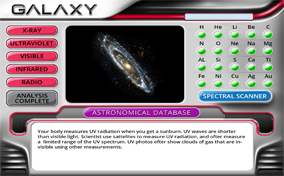Here are some definitions to help you in your investigation.
Astronomy – the science of studying objects in space
Wave Peak – the tallest point on a wave
Wave Trough – the lowest point on a wave
Wavelength – the distance from one wave peak to the next wave peak
Cycle – one complete up and down pattern of a wave
Frequency – the length of time to complete one cycle of the wave
Energy – the ability to do work
Astronomer – a person who studies objects in space
Planet – a planet 1) orbits a star, 2) is big enough to have enough gravity to force a spherical shape, and 3) is big enough that its gravity cleared away any objects of a similar size near its orbit. The planets in our solar system in order from the sun are Mercury, Venus, Earth, Mars, Jupiter, Saturn, Uranus, and Neptune. Some still consider Pluto to be a planet, which is located farthest from the sun.
Moon – a natural space object that revolves around a planet
Star – a space object in the shape of a sphere that is emitting light or other types of energy and is made up of matter mostly in the plasma phase of matter. The Sun is Earth’s nearest star.
Galaxy – a system of millions or billions of stars, gases, and dust that make up the universe
Database – an organized collection of information that can be quickly accessed
What is a wave?
A wave is a disturbance that transmits energy from one place to another. A wave does not need
to transport matter to transmit the energy from the source to another location.
What is a wavelength?
The wavelength is the length from one peak or highest point on a wave to the nearest peak.
What is a wave's frequency?
A wave's frequency is the number of cycles or repeating waves per unit time. A wave with a long wavelength has a low frequency, while a wave with a short wavelength has a high frequency.
What is the electromagnetic spectrum (EMS)?
The EMS defines the range of frequencies of the various forms of electromagnetic waves. In order from highest to lowest frequency, the spectrum goes: Gamma rays, X-rays, ultraviolet, visible light, infrared, microwaves, and radio waves. The wave order is reversed for wavelength going from longest to shortest wave, with radio waves being the longest (some are tens of meters long) to gamma rays, which can have lengths shorter than one angstrom.
What is the wave speed of electromagnetic waves?
All electromagnetic waves travel at the same speed in a vacuum: 3.0 X 108 meters per second.
How is energy related to electromagnetic waves?
The energy (photon energy) of an electromagnetic wave is directly proportional to wave frequency. Therefore, the wave with the highest frequency is most energetic, while the wave with the lowest frequency is least energetic.
What is astronomical spectroscopy?
Astronomers use astronomical spectroscopy to study the electromagnetic waves radiating from celestial objects. Astronomers use various frequencies of the electromagnetic spectrum to observe and measure characteristics of celestial objects to determine their chemical makeup and other traits.
What is a spectral scanner?
A spectral scanner is a device that determines the element or elements present when an object is heated or exposed to an electric charge.
What are the terrestrial planets?
Our solar system has two main team players: the rocky all-stars and the gassy giants. The rocky all-stars, closer to the sun and feeling the heat, are called the terrestrial planets. Earth is one of them! These four planets share some cool features.
Imagine a giant rock with a surprise inside! Terrestrial planets are like that. They're mostly solid, made of tough stuff like iron and rock. Inside, they have a hot, dense core, kind of like a fiery center. They're also layered, with a middle mantle and a rocky outer crust, just like a giant chocolate cake (minus the chocolate!).
Being close to the sun has its perks and challenges. The terrestrial planets get blasted with sunlight, making some super hot (Venus) and others quite chilly (Mars). Some even have no atmosphere at all (Mercury)! But hey, they're the rocky foundation of our solar system family!
What are the gas giant planets?
Swinging out past the rocky planets in our solar system are the gas giants, the heavyweight champions! Unlike their rocky cousins, these whoppers are mostly gas, like giant cosmic balloons. Jupiter and Saturn are the leaders of the pack.
Imagine a swirling ball of gas with a surprise in the center! Unlike Earth's solid core, gas giants have a much smaller, denser core made of rock and ice. But the real stars are the staggering layers of gas above, mostly hydrogen and helium. These gases get squished and heated the deeper you go, creating some wild weather patterns!
These giants are far from the sun's heat, so they're freezing cold. But don't let that fool you. They have wild storms with winds faster than anything on Earth, and even features like the Great Red Spot on Jupiter, a giant, swirling storm bigger than Earth! Gas giants may not be made of rock, but they're definitely fascinating members of our solar system family.
What's in the Milky Way Galaxy?
Our galactic neighborhood, the Milky Way, is a swirling city of stars! But what exactly makes it tick? Imagine a giant disk sprinkled with stars, dust, and gas, all held together by gravity's invisible web. That's the basic structure of our galaxy.
The stars are the flashy celebrities, like billions of suns. They come in all sizes and colors, some burning hot and blue, others cooler and red. But stars aren't the only residents. There's also a giant cloud of dust and gas, mostly hydrogen, spread throughout the galaxy. This dusty attic holds the raw materials for new stars to be born.
And that's not all! Scientists believe there's a mysterious substance called dark matter that we can't directly see, but its gravity plays a huge role in holding the galaxy together. So, our galaxy is a cosmic mix of stars, dust, gas, and dark matter, all working together in a giant, beautiful dance.
What are the major types of galaxies?
The universe is full of galactic neighborhoods, but not all are created equal! There are three main types of galaxies, each with its own starry style.
First up are the spiral galaxies, like our own Milky Way. Imagine a giant pinwheel, swirling with stars. They have a bright, central bulge packed with older stars, and long, dusty arms spiraling outwards where new stars are born. Pretty cool, right?
Then there are the elliptical galaxies, the galactic grandpas. Picture a giant, smooth blob of stars, kind of like a blurry basketball. These are mostly older stars, with very little dust and gas left for creating new ones. They're calmer and more settled than their spiral cousins.
Last but not least, there are the irregular galaxies, the messy roommates of the galactic bunch. They don't have a clear shape, more like a scattered cloud of stars, dust, and gas. They're kind of the wild cards of the universe, full of surprises and ongoing star formation.
So, next time you look up at the night sky, remember – those twinkling stars might be part of a giant pinwheel, a smooth blob, or even a messy splatter of a galaxy!
What is a nebula?
Imagine a giant cloud of colorful gas and dust floating in space – that's a nebula! These stellar nurseries are the cradles of new stars. Cold dust clumps together, and gravity pulls them tighter, heating them up. Eventually, the hottest clumps ignite, becoming shining stars.
Nebulas come in all sorts of shapes and colors. Some are red, glowing from the light of young stars inside. Others are dark and wispy, like smoke trails left behind by dying stars. No matter the look, nebulas are essential for creating the next generation of stars, keeping the universe sparkling bright!
 How can you tell what something is when it's too far away to actually visit? Astronomers use a variety of tools to explore the universe from afar. Your challenge is to identify unknown celestial objects by observing the emission from these objects using various parts of the electromagnetic spectrum. You will use tools like a spectral scanner, emission scanner, an astronomical database, and your own keen observation skills to determine the identity of unknown objects. So, put on your astro-thinking cap and get ready to head for the stars, and planets, and galaxies, and to infinity and beyond!
How can you tell what something is when it's too far away to actually visit? Astronomers use a variety of tools to explore the universe from afar. Your challenge is to identify unknown celestial objects by observing the emission from these objects using various parts of the electromagnetic spectrum. You will use tools like a spectral scanner, emission scanner, an astronomical database, and your own keen observation skills to determine the identity of unknown objects. So, put on your astro-thinking cap and get ready to head for the stars, and planets, and galaxies, and to infinity and beyond!)


